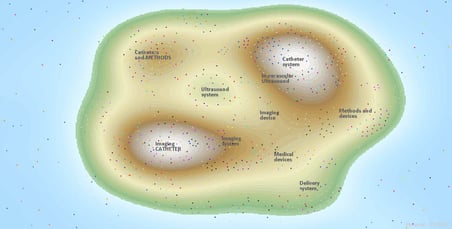A white space analysis is a way to identify risks and opportunities to inform business strategy. A patent white space analysis reviews the patent landscape of a specific technology to find areas that are not highly protected. These analyses are often automatically generated searches using classification codes, key words or citation analysis. The graphical result sometimes looks like a topographical map of an island with clusters of patents being the peaks. “Mountains” denote areas with many patents.
This type of visualization is a static snapshot of patent filings showing open spaces based on low patent counts. But can it tell us important information like the filing histories of the key players? Or what is being filed globally? Or what is likely going to be filed down the road? Not really.
It is often more useful to understand the trends in patent filings in a specific technology space of interest.
For example:
- Is a company filing many patents in a particular field or evenly across the entire technology space?
- Are they developing large patent families around a specific technology?
- Has a company filed any new patents in a field in the past few years or have they shifting their focus to a different field altogether?
- Are they filing in multiple jurisdictions?
Richer trend data reveals the strategy companies are using to protect their IP and what new products they may soon be offering. This valuable competitive insight can then be used to guide R&D efforts and IP strategy.
Such intelligence can’t be derived simply from an algorithm automatically generating data downloads. A more comprehensive white space analysis requires human interpretation to make sense of the data, perform additional searches, do some digging on the key players, and prepare the data in a manner that can be easily understood and acted upon.
Automatically generated patent white space islands with their topographical features may look pretty, but as with any complex map you often need a human guide to ensure that you can successfully navigate the peaks and valleys to reach your desired destination!
This article was published more than 1 year ago. Some information may no longer be current.


